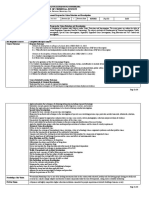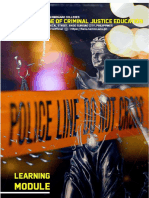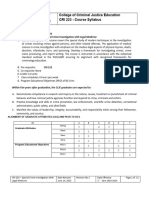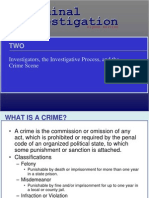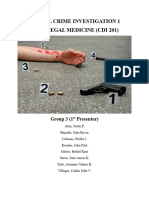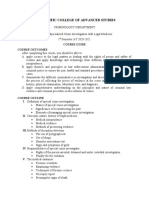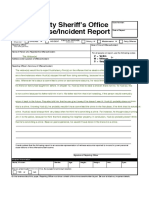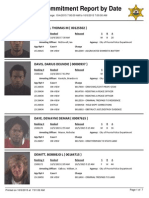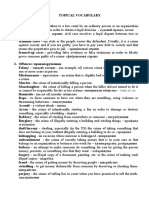TOS
Uploaded by
batchobryan3TOS
Uploaded by
batchobryan3CRIMINOLOGY
Subject Code: CRI 183
Subject Title: Law Enforcement Operations w Crime Mapping
B
COURSE-LEVEL OBJECTIVES TOPIC/LESSON MODULE NO. Easy
Remembering
1
Planning as Management
10 0
Function
0
0
Category of Plans 11 0
0
1
Articulate the principles and Three Dimensions of
elements of planning, types of Planning 12 1
plans, classification of plan, and 0
the law enforcement plans. 0
Patrol Plan 2030, PGS
Strategic Plan Technologies 14 1
1
0
Five(5) Major Approaches in
15 0
Police Planning
0
0
Guides to a Good Plan 16
0
1
Introduction to Crime 1
19
Mapping 0
Discuss the key application in
crime mapping and crime 0
analysis (thematic mapping, 0
non-graphical indicators, Historical Background of
20 0
hotspots, spatial regression, crime mapping
and geographic profiling), and 0
the geographic information of 1
crimes 0
Micro-Macro Level Theories
21
of crime 0
0
BFAR (Bureau Of Fisheries 0
and Aquatic Resources) and 0
4
its Law Enforcement 0
Operations 0
PCG (Philippine Coast Guard 0
) and its Law Enforcement 5 0
Operations 0
0
LTO (Land Transportation 0
Office) and its Law 7 0
Enforcement Operations 0
0
0
PDEA (Philippine Drug 0
Apply the steps in law Enforcement Agency) and its 6 0
enforcement planning and Law Enforcement Operations 0
operations of PNP, BFP, PCG, 0
NBI, PDEA and BID 0
0
PNP 0
0
0
0
0
BFP
0
0
0
NBI 0
0
0
BID 0
0
0
0
0
Crime Analysis 22
0
0
0
0
0
Apply the skills on place and Map Information 23 0
environmental design, and
0
crime incidence situation as
applied to GIS 0
0
Map Data 24 0
0
0
0
Mapping software and
25
resources
Mapping software and
25 0
resources
0
0
0
0
RA 7438 2 0
0
0
0
0
Rule 113 of the Rules of
3 0
Court
0
Evaluate the constitutional and 0
statutory rights of persons
0
affected by law enforcement
operations. 0
Rule 126 of the Rules of
4 0
Court
0
0
0
0
Rule 110 of the Rules of 0
5
Court 0
0
0
8
Distribution of Complexity Level 30%
Note: Easy Questions - 30%, Modera
NOLOGY
Lead Dean Hadenar Negos
Lead
PEN NCR
School:
Bloom's Level / Cognitive Complexity
Easy Medium Difficult
Item No. Validated
Understanding Applying Analyzing Evaluating Creating
0 0 0 0 0 1 1
1 0 0 0 0 2 1
1 0 0 0 1 3 1
1 0 0 0 0 4 1
1 0 0 0 0 5 1
1 0 0 0 0 6 1
0 0 0 0 0 7 1
0 0 0 0 0 8 1
1 0 0 0 0 9 1
1 0 0 0 0 10 1
0 0 0 0 0 11 1
0 0 0 0 0 12 1
1 0 0 0 0 13 1
1 0 0 0 0 14 1
1 0 0 0 0 15 1
1 0 0 0 0 16 1
1 0 0 0 0 17 1
0 0 0 0 0 18 1
0 0 0 0 0 19 1
1 0 0 0 0 20 1
1 0 0 0 0 21 1
1 0 0 0 0 22 1
1 0 0 0 0 23 1
1 0 0 0 0 24 1
0 0 0 0 0 25 1
1 0 0 0 0 26 1
1 0 0 0 0 27 1
1 0 0 0 0 28 1
0 1 0 0 0 29 1
0 1 0 0 0 30 1
0 1 0 0 0 31 1
0 1 0 0 0 32 1
0 1 0 0 0 33 1
0 1 0 0 0 34 1
0 1 0 0 0 35 1
0 1 0 0 0 36 1
0 1 0 0 0 37 1
0 1 0 0 0 38 1
0 1 0 0 0 39 1
0 1 0 0 0 40 1
0 1 0 0 0 41 1
0 1 0 0 0 42 1
0 1 0 0 0 43 1
0 1 0 0 0 44 1
0 1 0 0 0 45 1
0 1 0 0 0 46 1
0 1 0 0 0 47 1
0 1 0 0 0 48 1
0 1 0 0 0 49 1
0 1 0 0 0 50 1
0 1 0 0 0 51 1
0 1 0 0 0 52 1
0 1 0 0 0 53 1
0 1 0 0 0 54 1
0 1 0 0 0 55 1
0 1 0 0 0 56 1
0 1 0 0 0 57 1
0 1 0 0 0 58 1
0 1 0 0 0 59 1
0 1 0 0 0 60 1
1 0 0 0 0 61 1
0 0 1 0 0 62 1
0 0 1 0 0 63 1
0 1 0 0 0 64 1
0 1 0 0 0 65 1
0 0 0 0 1 66 1
1 0 0 0 0 67 1
0 0 0 1 0 68 1
0 0 0 1 0 69 1
0 0 0 0 1 70 1
0 1 0 0 0 71 1
0 0 1 0 0 72 1
0 0 1 0 0 73 1
0 0 1 0 0 74 1
0 0 1 0 0 75 1
0 1 0 0 0 76 1
0 1 0 0 0 77 1
0 0 1 0 0 78 1
0 0 1 0 0 79 1
0 0 0 1 0 80 1
0 0 0 1 0 81 1
0 0 0 1 0 82 1
0 0 0 1 0 83 1
0 0 0 1 0 84 1
0 0 0 0 1 85 1
0 0 0 0 1 86 1
0 0 0 1 0 87 1
0 0 0 1 0 88 1
0 0 0 1 0 89 1
0 1 0 0 0 90 1
0 0 1 0 0 91 1
0 0 0 1 0 92 1
0 0 0 1 0 93 1
0 0 0 1 0 94 1
0 0 0 0 1 95 1
0 0 0 0 1 96 1
0 0 0 1 0 97 1
0 1 0 0 0 98 1
0 1 0 0 0 99 1
0 0 1 0 0 100 1
22 40 10 14 7
30% 50% 21%
te: Easy Questions - 30%, Moderate Questions - 50%, Difficult Questions, 20%
CRIMINOLOGY
Subject Code: CRI 174
Subject Title: Specialized Crime Investigation 1
COURSE-LEVEL OBJECTIVES TOPIC/LESSON MODULE NO.
Enumerate and explain the principles Concepts and Principles of
and kinds of criminal investigation Criminal
Scene of the Investigation
Crime operation Module 1
Define SOCO (SOCO)
Scene of the Crime operation Module 2
Familiarize the function of SOCO (SOCO)
Scene of the Crime operation Module 2
Enumerate the composition of SOCO (SOCO)
Scene of the Crime operation Module 2
Familiarize the function of SOCO (SOCO) Module 2
Distinguish the different procedures Crime Scene
in crime scene processing Processing/Investigation Module 3
Identify the ethical consideration of Crime Scene
crime scene investigation Processing/Investigation Module 3
Crime Scene
Perform Crime Scene Processing Processing/Investigation Module 3
Distinguish the basic concepts of Crime Scene Documentation
Crime Scene Search and Recording Module 4
Classify the procedures in Crime Crime Scene Documentation
Scene Photography and Recording Module 4
Distinguish the general classifications Open Wound: its type,
of open wounds classification and characteristics Module 5
Classify the medical classifications of Open Wound: its type,
open wounds classification and characteristics Module 5
classification and
Distinguish the general classifications characteristics/ fracture and
of closed wounds, gunshot Module 6
classification and
Classify the medical classifications of characteristics/ fracture and
closed wounds.
Describe Gunshot wound and gunshot
characteristics/ fracture and Module 6
Fractures. gunshot Module 6
Describe the severity of wound Wound: its Severity and Fatality Module 7
Explain the
Identify Fatal wound types of
different Wound:
Types its Severity and Fatality
of weapon/instrument Module 7
instrument used to caused wound used to caused wound/injury Module 8
Describe the characteristics of wound Types of weapon/instrument
caused by each instrument used to caused wound/injury Module 8
BURN: Its Classification and
Enumerate the classification of Burn Degree Module 9
Describe the degree of Burn in a BURN: Its Classification and
person the types and classification
Describe Degree
Poison: its Type, Classification Module 9
of Poison
Identify the organs to examine in and symptoms
Poison: its Type, Classification Module 10
case of poisoning. and symptoms Module 10
Describe the symptoms in a Poison: its Type, Classification
poisoned person and symptoms Module 10
Enumerate and explain different
types of drowming Drowning Module 11
Classify the kinds of death Death: types and kinds Module 12
Compare and contrast different types
of death Death: types and kinds Module 12
Death: Signs and changes in
Distinguish the signs of death the body Module 13
Differentiate the changes in the body Death: Signs and changes in
after death the body Module 13
Distinguish the elements of Parricide, Parricide Investigation Module 14
Classify the concept of Parricide Parricide Investigation Module 14
Distinguish the elements of Murder Murder Investigation Module 15
Classify the evidence needed in the
filing of Murder, Murder Investigation Module 15
Classify the elements of Infanticide Infanticide Investigation Module 16
Distinguish the evidence needed in
the filing of Infanticide, and the
characteristics of suspects. Infanticide Investigation Module 16
Classify elements, and interpret
concept of abortion Abortion Module 17
Classify elements, and interpret
concept of abortion Abortion Module 17
Interpret the concept of the Physical
Injury. Physical Injuries Module 18
Classify the different Physical Injury,
and its implication to investigation Physical Injuries Module 18
Interpret the concepts of sex crime. Sex Crime/Rape Module 19
Distinguish the salient principles of
sex crime. Sex Crime/Rape Module 19
Examinelaw
Identify thethat
functions
protectofabuse
VAWC Child Abuse VAWC Module 20
children Child Abuse VAWC Module 20
Differentiate RA 7610 and RA 9262 Child Abuse VAWC Module 20
Differentiate RA 7610 and RA 9263 Child Abuse VAWC Module 20
Classify the concept of Suicide Suspected Suicide Investigation Module 21
Apply the procedures in the
conducting Suicide investigation, Suspected Suicide Investigation Module 21
Distribution of Complexity Level
CRIMINOLOGY
Lead Dean MAY MIGUEL
Lead
UI
School:
Bloom's Level / Cognitive Complexity
Easy Medium Difficult
Item No.
Remembering Understanding Applying Analyzing Evaluating Creating
0 1 0 0 0 0 1
0 0 0 0 1 0 2
0 1 0 0 0 0 3
0 0 0 0 1 0 4
0 0 0 0 1 0 5
1 0 0 0 0 0 6
0 1 0 0 0 0 7
0 0 1 0 0 0 8
0 0 1 0 0 0 9
0 0 0 1 0 0 10
0 0 0 0 1 0 11
0 1 0 0 0 0 12
0 1 0 0 0 0 13
0 0 1 0 0 0 14
0 0 1 0 0 0 15
0 0 1 0 0 0 16
0 0 0 1 0 0 17
0 0 0 1 0 0 18
0 0 1 0 0 0 19
0 0 1 0 0 0 20
0 0 0 1 0 0 21
0 0 0 0 1 0 22
0 0 1 0 0 0 23
0 0 0 0 1 0 24
0 0 0 1 0 0 25
0 0 0 1 0 0 26
0 0 1 0 0 0 27
0 0 0 1 0 0 28
0 1 0 0 0 0 29
0 1 0 0 0 0 30
0 1 0 0 0 0 31
0 0 0 1 0 0 32
1 0 0 0 0 0 33
0 1 0 0 0 0 34
0 1 0 0 0 0 35
1 0 0 0 0 0 36
0 1 0 0 0 0 37
0 1 0 0 0 0 38
0 1 0 0 0 0 39
1 0 0 0 0 0 40
0 1 0 0 0 0 41
0 1 0 0 0 0 42
0 1 0 0 1 0 43
0 0 0 0 1 0 44
0 0 0 0 0 0 45
0 0 1 0 0 0 46
0 0 1 0 0 0 47
0 0 0 0 1 0 48
0 0 0 0 1 0 49
0 0 0 1 0 0 50
0 0 0 1 0 0 51
0 1 0 0 0 0 52
0 0 0 1 0 0 53
0 0 0 0 1 0 54
0 0 0 1 0 0 55
0 0 0 1 0 0 56
0 0 0 1 0 0 57
0 0 0 1 0 0 58
0 0 0 1 0 0 59
0 0 0 1 0 0 60
0 0 0 1 0 0 61
0 0 0 1 0 0 62
0 0 0 1 0 0 63
0 0 0 1 0 0 64
0 0 0 1 0 0 65
0 0 0 0 1 0 66
0 0 0 0 1 0 67
0 1 0 0 0 0 68
0 1 0 0 0 0 69
0 1 0 0 0 0 70
0 0 1 0 0 0 71
0 0 1 0 0 0 72
0 0 0 0 1 0 73
0 1 0 0 0 0 74
0 0 1 0 0 0 75
0 0 1 0 0 0 76
0 0 1 0 0 0 77
0 0 1 0 0 0 78
0 1 0 0 0 0 79
0 1 0 0 0 0 80
0 0 0 1 0 0 81
0 0 0 1 0 0 82
0 0 0 0 1 0 83
0 1 0 0 0 0 84
0 1 0 0 0 0 85
0 0 0 1 0 0 86
0 0 0 1 0 0 87
0 0 0 1 0 0 88
0 0 0 1 0 0 89
0 0 0 0 1 0 90
0 0 0 0 1 0 91
0 0 0 0 1 0 92
0 0 0 1 0 0 93
0 0 0 0 1 0 94
0 0 0 0 1 0 95
0 1 0 0 0 0 96
0 0 0 1 0 0 97
0 0 1 0 0 0 98
0 0 1 0 0 0 99
0 0 1 0 0 0 100
4 26 20 30 20 0
30% 50% 20%
Note: Easy Questions - 30%, Moderate Questions - 50%, Difficult Questions, 20%
Validated
1
1
1
1
1
1
1
1
1
1
1
1
1
1
1
1
1
1
1
1
1
1
1
1
1
1
1
1
1
1
1
1
1
1
1
1
1
1
1
1
1
1
1
1
1
1
1
1
1
1
1
1
1
1
1
1
1
1
1
1
1
1
1
1
1
1
1
1
1
1
1
1
1
1
1
1
1
1
1
1
1
1
1
1
1
1
1
1
1
1
1
1
1
1
1
1
1
1
1
1
You might also like
- Cdi 1 Fundamentals of Criminal Investigation & Intelligence - Powerpoint89% (19)Cdi 1 Fundamentals of Criminal Investigation & Intelligence - Powerpoint22 pages
- Specialized Crime Investigation 1 With Legal Medicine96% (23)Specialized Crime Investigation 1 With Legal Medicine7 pages
- Course Audit 1 Course Content and Requirements 2024No ratings yetCourse Audit 1 Course Content and Requirements 20245 pages
- CDI 2 Specialized Crime Investigation 1 With.pptx 1 2No ratings yetCDI 2 Specialized Crime Investigation 1 With.pptx 1 241 pages
- College of Criminal Justice: Outcomes-Based SyllabusNo ratings yetCollege of Criminal Justice: Outcomes-Based Syllabus8 pages
- Module 1 - Nature and Concept of Criminal InvestigationNo ratings yetModule 1 - Nature and Concept of Criminal Investigation10 pages
- Criminal Investigation Course Outline - 2025No ratings yetCriminal Investigation Course Outline - 202518 pages
- Instructional Manual in Specialized Crime Investigation 1 With Legal Medicine 2024 25 ReferenceNo ratings yetInstructional Manual in Specialized Crime Investigation 1 With Legal Medicine 2024 25 Reference63 pages
- Understanding Criminal Investigation 1st Edition Stephen Tong download100% (1)Understanding Criminal Investigation 1st Edition Stephen Tong download47 pages
- Final Version of F Investigation ReviewedNo ratings yetFinal Version of F Investigation Reviewed3 pages
- Fundamentals of Criminal Investigation and IntelligenceNo ratings yetFundamentals of Criminal Investigation and Intelligence252 pages
- Criminal Investigation: Investigators, The Investigative Process, and The Crime SceneNo ratings yetCriminal Investigation: Investigators, The Investigative Process, and The Crime Scene19 pages
- Course Syllabus Cdi 2 (Specialized Investigation 1 With Legal Medicine)No ratings yetCourse Syllabus Cdi 2 (Specialized Investigation 1 With Legal Medicine)15 pages
- CDI 102 - Specialized Crime Investigation With Legal Medicine100% (13)CDI 102 - Specialized Crime Investigation With Legal Medicine16 pages
- Criminal Investigation 11th Edition – Ebook PDF Version 2024 Scribd Download100% (3)Criminal Investigation 11th Edition – Ebook PDF Version 2024 Scribd Download55 pages
- Program of Instructions FOR: Criminal Investigation and Detective Management Course (38 Days)No ratings yetProgram of Instructions FOR: Criminal Investigation and Detective Management Course (38 Days)3 pages
- Cdi 1 - Fundamental of Criminal InvestigationNo ratings yetCdi 1 - Fundamental of Criminal Investigation38 pages
- Criminal Investigation The Art and The Science 6th Edition PDFNo ratings yetCriminal Investigation The Art and The Science 6th Edition PDF49 pages
- Module For Special Crime Investigation With Legal Med. Mid Term1No ratings yetModule For Special Crime Investigation With Legal Med. Mid Term166 pages
- CRIME SCENE PROCESSING - Evidence Collection - STUDENTNo ratings yetCRIME SCENE PROCESSING - Evidence Collection - STUDENT3 pages
- People Vs Quijada 115008 July 24, 1996 J Davide JR en BancNo ratings yetPeople Vs Quijada 115008 July 24, 1996 J Davide JR en Banc25 pages
- 13.9 PP vs. Bernabe GR No. 185726 October 16, 2009No ratings yet13.9 PP vs. Bernabe GR No. 185726 October 16, 20099 pages
- ADMIN - I - 16. Roquero VS, Chancellor of UP-Manila GR No. 181851No ratings yetADMIN - I - 16. Roquero VS, Chancellor of UP-Manila GR No. 1818512 pages
- Crim Pro Digest Lacson V Executive Secretary 301 SCRA100% (1)Crim Pro Digest Lacson V Executive Secretary 301 SCRA2 pages
- United States v. Tony R. Jake, A/K/A Smiley, 281 F.3d 123, 3rd Cir. (2002)No ratings yetUnited States v. Tony R. Jake, A/K/A Smiley, 281 F.3d 123, 3rd Cir. (2002)11 pages
- The Killing of Kenneth Chamberlain Sr. - A Hate CrimeNo ratings yetThe Killing of Kenneth Chamberlain Sr. - A Hate Crime2 pages
- BB Pande, “Criminal Law and Criminal Justice Advanced Legal Writings”, In Writing XII Interlocking Nature of the Procedural Due Process and the Constitutional Due Process 244-282 (Eastern Book Company 2022).No ratings yetBB Pande, “Criminal Law and Criminal Justice Advanced Legal Writings”, In Writing XII Interlocking Nature of the Procedural Due Process and the Constitutional Due Process 244-282 (Eastern Book Company 2022).40 pages













